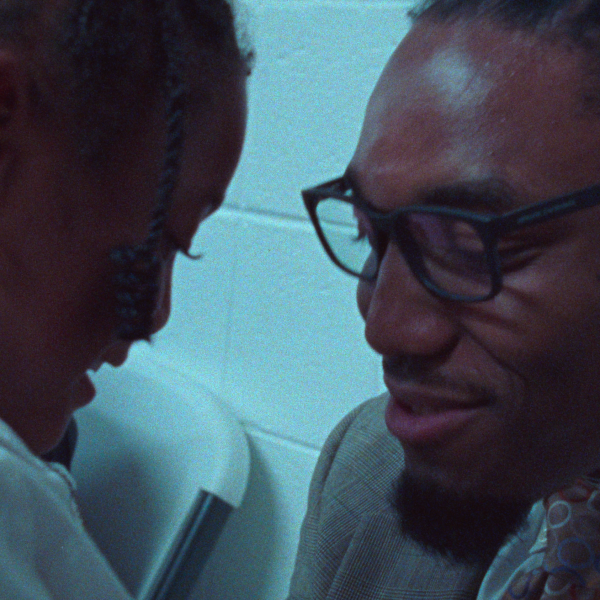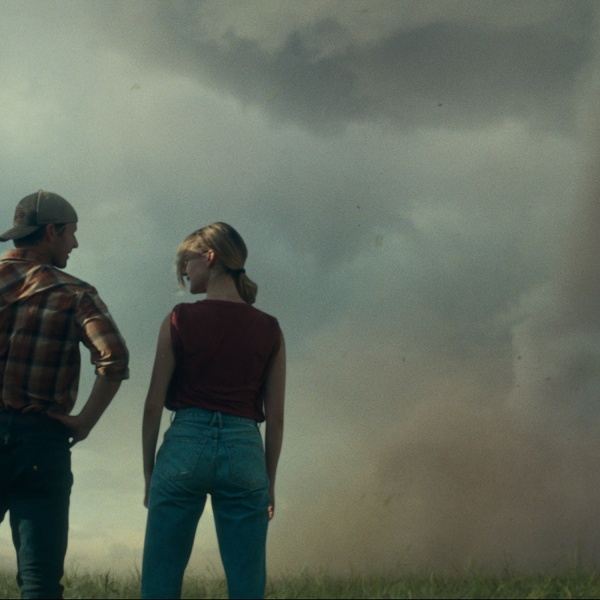A pack of wolves howls at a massive iPhone that’s propped up in the snow like a monolith, an image from George Méliès “A Trip to the Moon” frozen on its screen. A steampunk Trojan horse — or is it an ark? — delivers a fleet of small children into the future, where they’re greeted by a marionette wearing a mask of Greta Thunberg’s face. Mike Tyson, dressed in the most fantastic Afrofuturist chic, pumps up the youngest survivors of a nuclear and/or robot-induced apocalypse in the middle of a boxing ring that’s held together with actual ropes.
These are just some of the surreal but stiflingly hyper-legibible sights on display in Godfrey Reggio’s “Once Within a Time,” a 43-minute curio that would seem to find the “Koyaanisqatsi” director venturing beyond the time-lapse technophobia that made his documentary work so iconic. And to a degree, it does, insofar as this strange new experiment — less scripted than staged — revisits early cinema with the same doom-laden playfulness that his previous work used to push the medium forward.
But Reggio has never been afraid of tweaking his visuals in order to refine his vision (even if 2013’s austere “Visitors” and 2002’s nightmarish “Naqoyqatsi” did more to dilute it than anything else), and that vision still hasn’t changed in the 41 years since he first saw the design of a microchip as a metaphor for modern life: Technology has always been a symptom of the societies that created it, and the extent to which our world has come to revolve around it reveals a sickness that runs far deeper than nuclear power, social media, or — insert digital age boogeyman here — alone.
Observing Reggio’s thematic consistency isn’t meant as a criticism; there’s no sense begrudging an artist for obsessively returning to the big idea that motivates their work. Be that as it may, the same obviousness that felt so eye-opening in “Koyaanisqatsi” has become a cross to bear for a filmmaker whose experientialist maximalism has never allowed for subtlety or nuance, and “Once Within a Time” — co-directed by Jon Kane, and billed as “a bardic fairy tale about the end of the world and the beginning of a new one” — is ultimately made all the more familiar by Reggio’s efforts to re-interpret his usual message into a wordless language far wackier than the one his documentaries helped to invent.
It looks wild, it sounds amazing, and it goes by in a flash (the end credits start to roll after just 43 minutes), but where the best moments of the “Qatsi” trilogy left room for viewers to make sense of the world for themselves, the even more expressionistic approach Reggio adopts here has a perversely limiting effect. Where the sight of people streaming through Grand Central Station at light-speed provoked wonder and worries of terminal velocity in equal measure, the far weirder image of a man-sized Apple of Knowledge wowing Adam and Eve with a glimpse at the screen in his chest doesn’t leave any room for interpretation. Reggio wants to dazzle you, but he’s deathly afraid of being misunderstood (a fear that extends to one of his signature closing title cards, which tries to put the onus on the audience by leaving us with an open-ended question).
In that light, it’s a good thing that Reggio can still dazzle us with the best of them. Even the most eye-rolling imagery in “Once Within a Time” is a wonder to behold (I’m looking at you, the bit where kids sitting on a small merry-go-round are replaced by iPhones), as Reggio and Kane find a jittery and transfixingly atemporal middle ground between past and future. The restless aesthetic invokes everything from “A Trip to the Moon” to Guy Maddin’s “Brand Upon the Brain!” and Ridley Scott’s “1984” commercial as it melts all of these influences and several more into an imagistic soup where digital lines skitter over sepia-tinted frames, and Wendy Carlos’ theme from “The Shining” is layered over shots of toy robots destroying the Earth.
The arc of the film’s aesthetic gradually becomes more fascinating than any of its individual bits, as the straight-to-the-camera simplicity that Reggio and Kane borrow from the silent era evolves into something more divided and unstable as chaos draws closer, only to be reset into a style that represents pre-cinema romanticism after the world is born anew as a technology-free utopia. Considering how explicitly “Once Within a Time” references other films, and the extent to which film itself becomes a recurring symbol over the course of Reggio and Kane’s apocalyptic catharsis, it’s tempting to lump this whole thing in with Harmony Korine’s “Aggro Dr1ft,” Victor Erice’s “Close Your Eyes,” and a host of other recent movies that are begging for/making peace with the emergence of a new cinema.
In the end, however, Reggio is a bit too bound by the old cinema for “Once Within a Time” to actually push forward — specifically his old cinema. It’s hard to hold the filmmaker’s favorite imagery against him (a Reggio movie just doesn’t hit the same without a montage of spaceship blasting off its launchpad), and no one in their right mind would complain about Reggio’s decision to reunite with the great Philip Glass for another score so commanding that the movie itself often feels like a glorified music video for it (Glass’ uncharacteristically percussive contributions are further enlivened by Iranian singer-composer Sussan Deyhim, who adds a physical thrust to his recursive minimalism).
But monkeys wearing VR goggles, money symbols raining over the unblinking faces of children, Greta Thunberg leading the next generation onto her spaceship… it doesn’t feel like she’s leading them into the future so much as she’s corralling them back to the same place that Reggio’s work has never been able to move beyond.
Grade: C+
Oscilloscope will release “Once Within a Time” in theaters on Friday, October 13.




